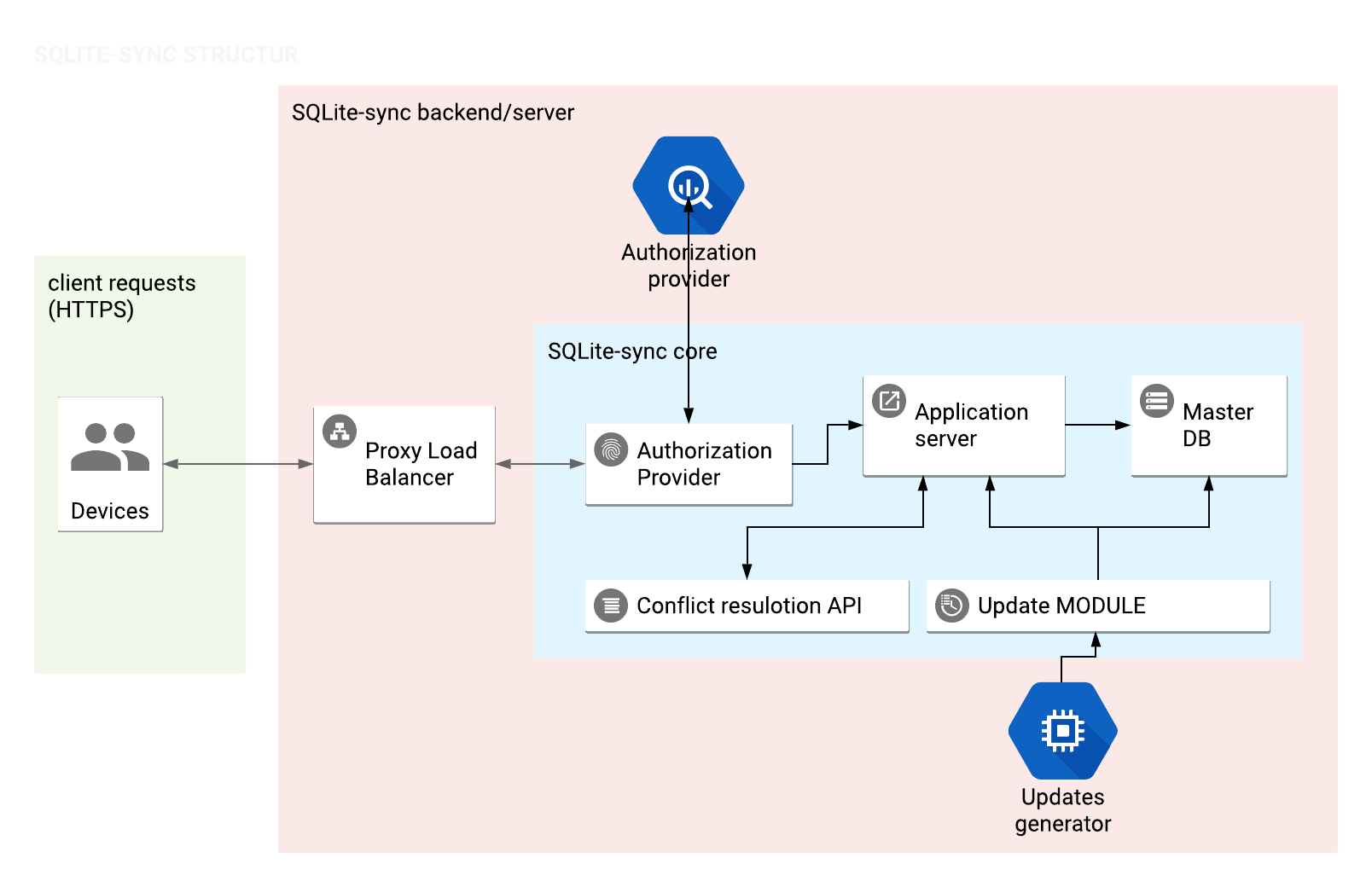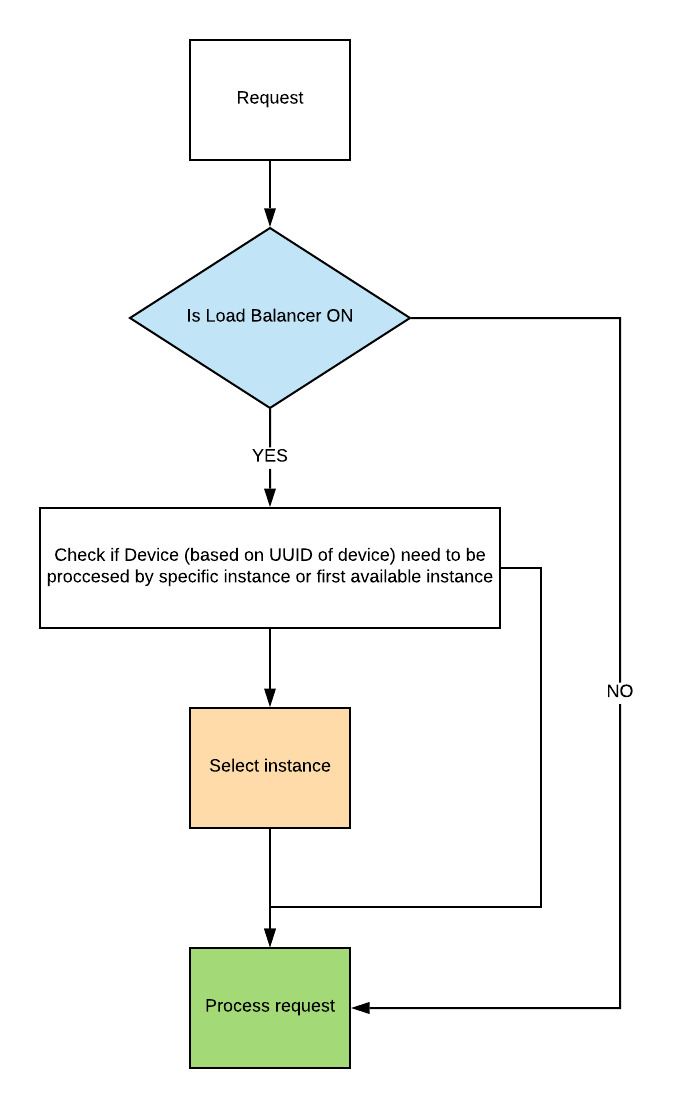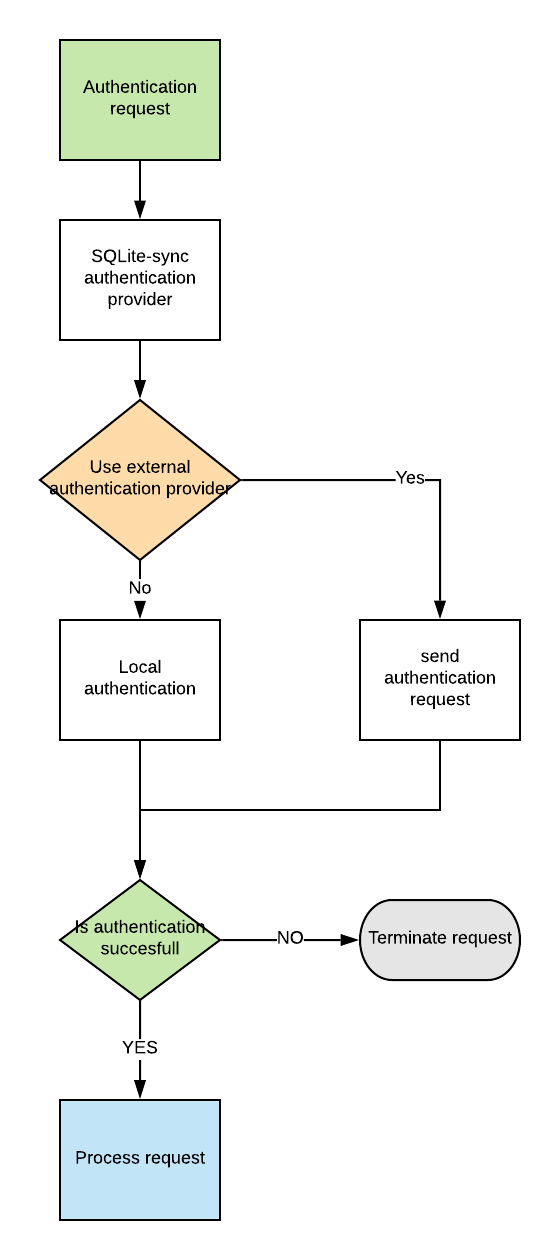Wiki » History » Revision 34
« Previous |
Revision 34/43
(diff)
| Next »
Tomek Dziemidowicz, 2019-07-18 09:03 PM
SQLite-sync documentation¶
Owner : AMPLIFIER sp. z o.o.
Contact : support (at) ampliapps.com
website : https://ampliapps.com
- Table of contents
- SQLite-sync documentation
Welcome to the AMPLI-SYNC documentation!
We have language bindings in JavaScript, .NET C#, Java and Objective-C!
AMPLI-SYNC concept¶
Solution diagram¶

- Devices communicate with server using HTTP/HTTPS protocol.
- Proxy Load Balancer. If necessary, proxy can redirect request to another instance of SQLite-core.
- Authorization provider will generate token based on response from authorization provider.
Proxy Balancer flowchart¶

Authorization Provider flowchart¶

REST API (server API)¶
Protocol version¶
This document describes integration with the REST API 3.x protocol.
Service description¶
There are two stages to processing a request:
- Device places an request.
- SQLite-sync server confirms the request has been processed successfully and sends confirmation with eventual conflict list that need to be resolved.
Synchronization flowchart¶

Request URL format¶
Sample REST API call:
https://example.com/API3/__method___
Explanation:
https://example.com/ - adres of REST API service
API3 - version of synchronization
method_ - method/action
API methods¶
API3 - control method¶
Method : GET
Path : “/API3”
Produces : TEXT_HTML
Description : control method. Returns “API[v3] SQLite-Sync.COM is working correctly!” if web service is correctly configured.
InitializeSubscriber - Reinitialize subscriber¶
Method : GET
Path : “/InitializeSubscriber/{subscriberUUID}”
Produces : TEXT_PLAIN
Description : Reinitialize subscriber, create empty schema on device, prepare master database for new subscriber.
- InitializeSubscriber Objective-C
- InitializeSubscriber .NET C#
- InitializeSubscriber JAVA
- InitializeSubscriber JavaScript
Sync - gets changes for table¶
Method : GET
Path : /Sync/{subscriberUUID}/{tableName}
Produces : TEXT_PLAIN
Description : Get changed data.
Params:
subscriberUUID - identifier of subscriber. By default device unique ID is used. But we can place there any value (also #user.UUID)
tableName - name of table from database (without schema)
Response:
<?xml version="1.0" encoding="utf-8"?>
<records>
<r a="1">
<c>2</c>
<c>Document</c>
<c>75541</c>
<c>2014-02-13 00:00:00</c>
<c>665.000</c>
<c>2c93d64e-cc72-11e3-87e0-f82fa8e587f9</c>
</r>
<r a="2">
<c>4</c>
<c>Document 4</c>
<c>4879</c>
<c>2014-04-23 13:44:48</c>
<c>4875.000</c>
<c>2c93d765-cc72-11e3-87e0-f82fa8e587f9</c>
</r>
</records>
<records> - section contains records
<r a=”1”> - here starts record.
</r> - here record ends
Attribute “a” (action type)
1 - new record
2 - update for record Implementation examples:
CommitSync - control method¶
Method : GET
Path : “/CommitSync/{syncId}”
Produces : TEXT_PLAIN
Description : If device recieved all changes without error this method should be call to tell server that there was no errors during receiving package. Params: syncId - id of data package
Conflict Resolution¶
Update procedure¶
Data filtering¶
Installation¶
Server Prerequisites¶
To make ampli-sync server work you need:- Apache Tomcat 8.
- Java
- Linux/Windows environment.
Manual¶
Steps needed to install AMPLI-SYNC manually on Ubuntu.
- Install Tomcat on Ubuntu:
https://www.digitalocean.com/community/tutorials/how-to-install-apache-tomcat-8-on-ubuntu-16-04 - Create new user
sudo adduser amplisync
System will ask you for password for newly created user. - Add user to group ‘tomcat’
sudo usermod -a -G tomcat amplisync
- Chang in web.xml path variable to
\home/sqlitesync/demo
- Install new application in Tomcat. Start with switching to amplisync user.
su amplisync
- Create new folder /home/sqlitesync/demo
- Upload new service amplisync-demo to Tomcat. You can do that using Tomcat application manager, or you can put WAR file in Tomcat webapps folder. Name of your WAR file is app name in Tomcat environment. Remember to not place spaces and special chars in name of your WAR file.
- Restart Tomcat:
service tomcat restart
Now you can access your installation using link:http://your_ip:8080/amplisync-app-name/API3
- Setup permissions:
chown -R sqlitesync:tomcat /home/amplisync/demo/
Docker¶
Configuring AMPLI-SYNC service¶
First you need to adjust website configuration file (web.xml), then you need to change main configuration file (sync.properties).Service configuration (web.xml)
Go to your_webapps_folder/SqliteSync/WEB-INF/web.xml and open for edit. Navigate to section:
<env-entry>
<env-entry-name>working-dir</env-entry-name>
<env-entry-type>java.lang.String</env-entry-type>
<env-entry-value>/your/working/dir/sqlite-sync/</env-entry-value>
</env-entry>
change env-entry-value key and point to working dir where SQLite-sync.com server will store log files, temporary files and configuration. Create manually a subfolder named config. Create a text file sync.properties in folder config. The path should look like this:
\working_dir\config\sync.properties
IMPORTANT Restart service after changing web.xml. Make sure that Tomcat has read/write access to working dir.
Sample configurations for MySQL server
DB_ENGINE = mysql DBURL = jdbc:mysql://server:3306/dbname?rewriteBatchedStatements=true DBUSER = user DBPASS = pass DBDRIVER = com.mysql.cj.jdbc.Driver DATE_FORMAT = yyyy-MM-dd HH:mm:ss HISTORY_DAYS = 7 LOG_LEVEL = 4
If you faced a timezone error after configuration in `sync.properties` add at the end of connection string:
&useUnicode=true&useJDBCCompliantTimezoneShift=true&useLegacyDatetimeCode=false&serverTimezone=UTC
Keys explanation
DB_ENGINE - type of database engine. Available options:
- mysql
- mssql
- postgresql
- oracle
LOG_LEVEL - defain details level for log
4: TRACE, DEBUG, INFO, WARN; (default)
3: DEBUG, INFO, WARN;
2: INFO,WARN;
1: WARN;
0 - disable logs
DATE_FORMAT - set format of date
default format: yyyy-MM-dd HH:mm:ss
HISTORY_DAYS - How long files with sync data will be kept
default value: 7
When you use MySQL database DO NOT remove from the end of the connection string:
?rewriteBatchedStatements=true
Supported databases¶
AMPLI-SYNC supports those databases:
- MySQL
- Microsoft SQL Server (2005 and newer)
- Oracle
- PostgreSQL
Supported columns data types¶
SQLite-sync.com uses own conversion table to match column data types when schema from master database is converted to sqlite database.- blob
- longblob
- varbinary
- binary
- image
- mediumblob
- varbinarymax
- byte[]
- longtext
- varchar
- nvarchar
- char
- varcharmax
- enum
- mediumtext
- text
- string
- geography
- geometry
- hierarchyid
- nchar
- ntext
- nvarcharmax
- userdefineddatatype
- userdefinedtabletype
- userdefinedtype
- variant
- xml
- tinytext
- set
- time
- timestamp
- year
- datetime
- uniqueidentifier
- datetime2
- date
- mediumint
- bit
- tinyint
- smallint
- bigint
- int
- boolean
- byte
- long
- int64
- serial
- int32
- smalldatetime
- double
- float
- numeric
- decimal
- real
- money
Primary Key requirements¶
Single and mupltiple columns are supported as primary key.
When column is AUTO_INCREMENT/SERIAL, identity pool management is handled by AMPLI_SYNC. It means when you insert a new record onto the device, the PK will be automatically changed for the first value available for device.
Samples¶
Updated by Tomek Dziemidowicz over 6 years ago · 34 revisions
Go to top